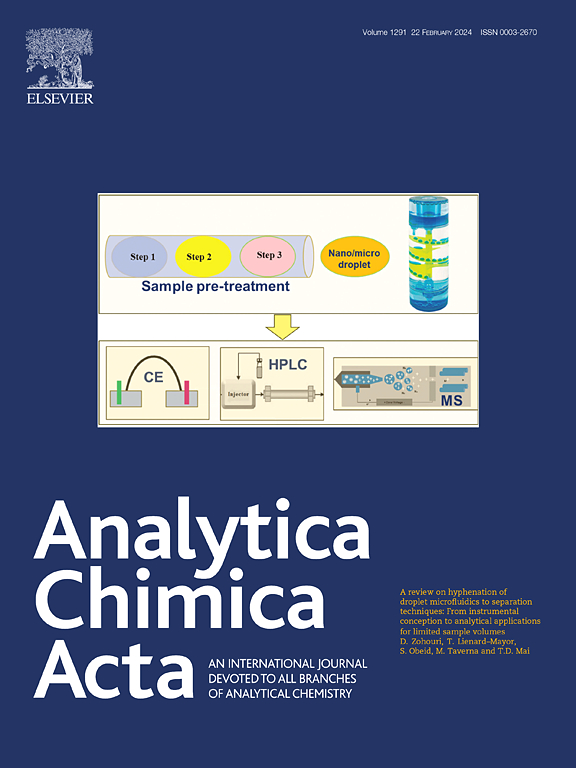Graphene Oxide-Based Dual-Color Thin-Film Fluorescent Nanolabels for Enhanced Immunochromatographic Detection of Pesticides
IF 5.7
2区 化学
Q1 CHEMISTRY, ANALYTICAL
引用次数: 0
Abstract
Background
The excessive use of pesticide pollutants in agricultural production seriously threatens food safety. Traditional detection techniques are difficult to meet the detection requirements due to the complex sample pretreatment and high detection costs. The immunochromatography method (ICA) is simple to operate and fast, and is suitable for on-site rapid detection. However, existing technologies still need to improve in terms of accuracy and sensitivity. Therefore, developing a new type of ICA technology with high sensitivity and specificity is an urgent task to meet the demand for on-site rapid detection.Results
This study introduces an advanced Dual-Color Gradient Fluorescent Immunochromatographic (DCG-FIC) system powered by graphene oxide-quantum dot nanolabels (G-TQD). By ingeniously engineering two-dimensional GO as a versatile nanoplatform, we developed dual-color fluorescent nanolabels that significantly enhances the sensitivity and specificity of small-molecule contaminant detection. Our DCG-FIC approach demonstrates substantial improvements in detection performance, achieving femtogram-level detection limits of 0.611 pg/mL for imidacloprid (IMI) and 2.16 pg/mL for azoxystrobin (AZO)—a notable 46-fold enhancement over conventional gold nanoparticle methods. The innovative thin-film nanostructure improves signal amplification and uniformity while reducing material consumption. With a rapid 15-minute detection protocol, spiked recovery rates of 85.13-105.14%, and relative standard deviations below 8.45%, this method offers a promising solution for multiplex pesticide residue screening in economic crops.Significance
This research innovatively developed a red-green dual fluorescence labeling system, combined with an intelligent reading device to achieve signal amplification, and was able to simultaneously complete high-precision detection of two target substances on a single detection line. This research provides a valuable framework for advancing biosensing platforms, integrating nanotechnology, fluorescence engineering, and immunoassay methodologies to support agricultural food safety and public health.

基于氧化石墨烯的双色薄膜荧光纳米标签用于增强免疫层析检测农药
农业生产中农药污染物的过量使用严重威胁着食品安全。由于样品预处理复杂,检测成本高,传统的检测技术难以满足检测要求。免疫层析法(ICA)操作简单、快速,适用于现场快速检测。然而,现有技术在准确性和灵敏度方面仍有待提高。因此,开发一种具有高灵敏度和特异性的新型ICA技术是满足现场快速检测需求的紧迫任务。结果介绍了一种由氧化石墨烯-量子点纳米标签(G-TQD)驱动的先进双色梯度荧光免疫层析(DCG-FIC)系统。通过巧妙地设计二维氧化石墨烯作为多功能纳米平台,我们开发了双色荧光纳米标签,显着提高了小分子污染物检测的灵敏度和特异性。我们的DCG-FIC方法在检测性能上有了实质性的改进,吡虫啉(IMI)的飞图级检测限为0.611 pg/mL,偶氮嘧菌酯(AZO)的飞图级检测限为2.16 pg/mL,比传统的金纳米颗粒方法提高了46倍。创新的薄膜纳米结构提高了信号放大和均匀性,同时减少了材料消耗。该方法快速检测15分钟,加标回收率为85.13 ~ 105.14%,相对标准偏差小于8.45%,为经济作物多重农药残留筛选提供了一种有前景的解决方案。本研究创新开发了红绿双荧光标记系统,结合智能读取装置实现信号放大,能够在一条检测线上同时完成对两种目标物质的高精度检测。该研究为推进生物传感平台、整合纳米技术、荧光工程和免疫分析方法提供了一个有价值的框架,以支持农业食品安全和公共卫生。
本文章由计算机程序翻译,如有差异,请以英文原文为准。
求助全文
约1分钟内获得全文
求助全文
来源期刊

Analytica Chimica Acta
化学-分析化学
CiteScore
10.40
自引率
6.50%
发文量
1081
审稿时长
38 days
期刊介绍:
Analytica Chimica Acta has an open access mirror journal Analytica Chimica Acta: X, sharing the same aims and scope, editorial team, submission system and rigorous peer review.
Analytica Chimica Acta provides a forum for the rapid publication of original research, and critical, comprehensive reviews dealing with all aspects of fundamental and applied modern analytical chemistry. The journal welcomes the submission of research papers which report studies concerning the development of new and significant analytical methodologies. In determining the suitability of submitted articles for publication, particular scrutiny will be placed on the degree of novelty and impact of the research and the extent to which it adds to the existing body of knowledge in analytical chemistry.
 求助内容:
求助内容: 应助结果提醒方式:
应助结果提醒方式:


